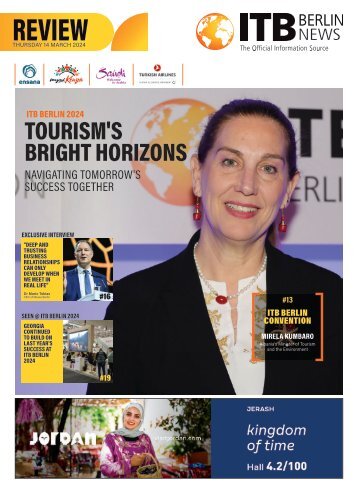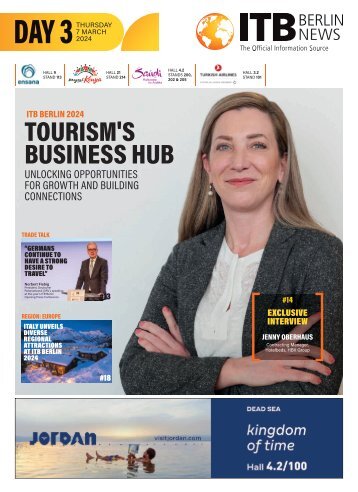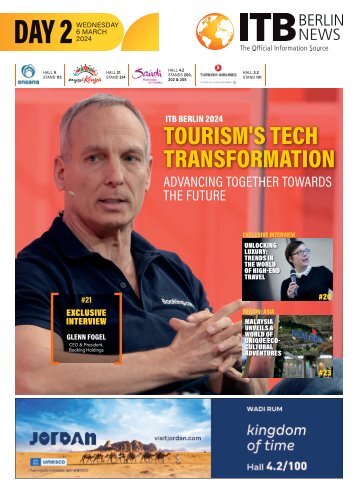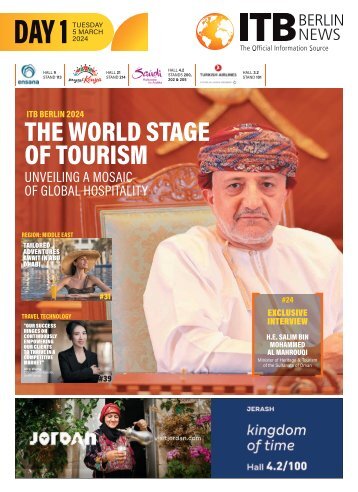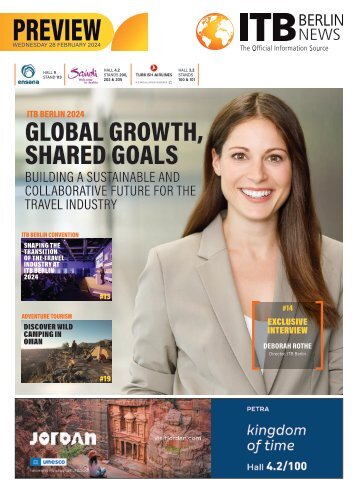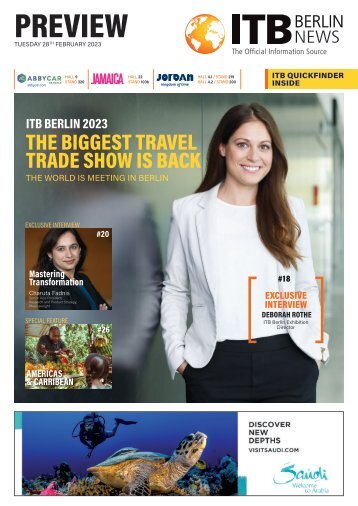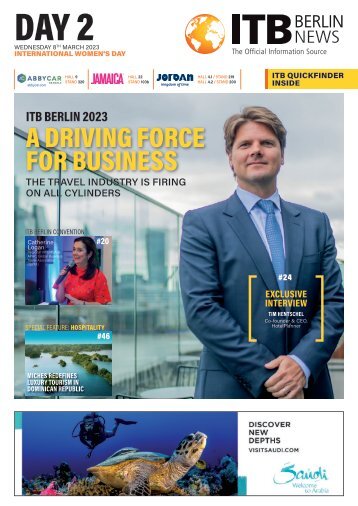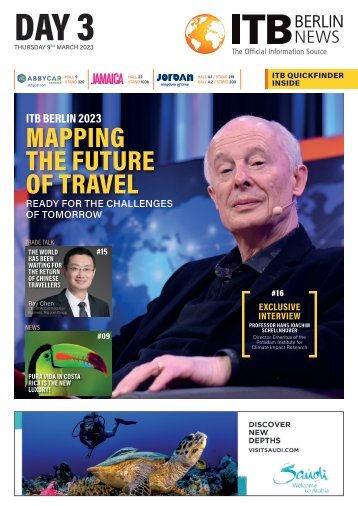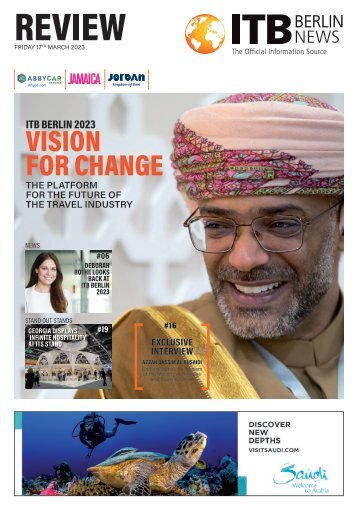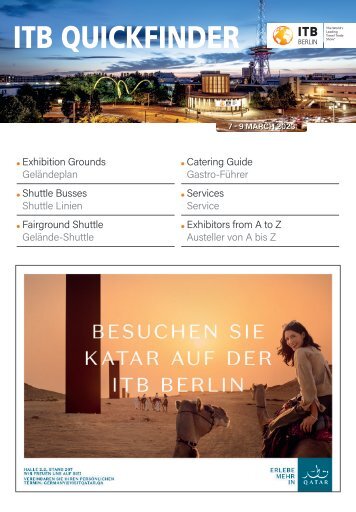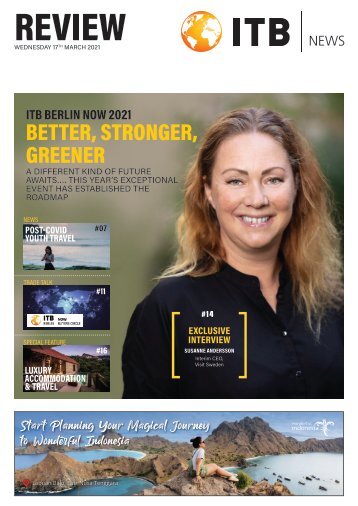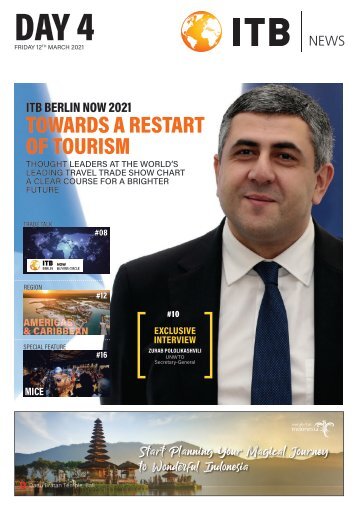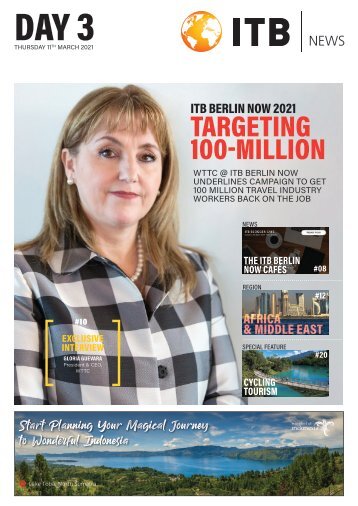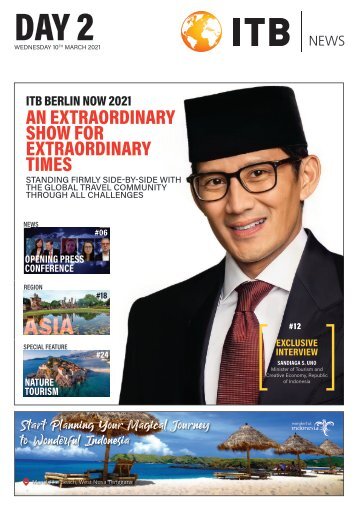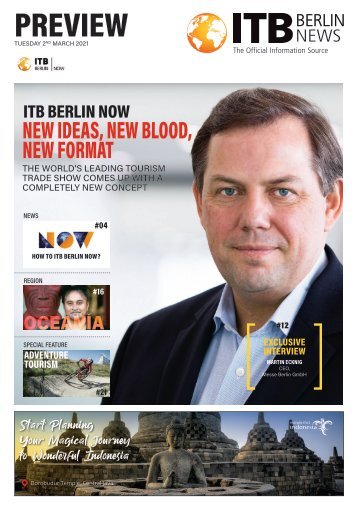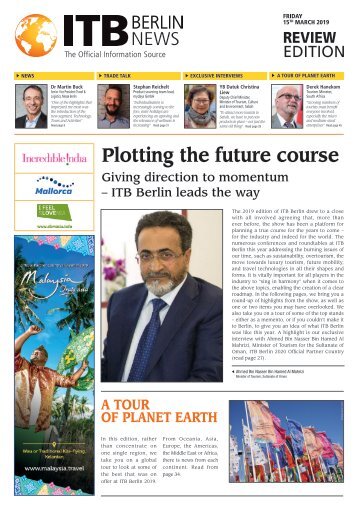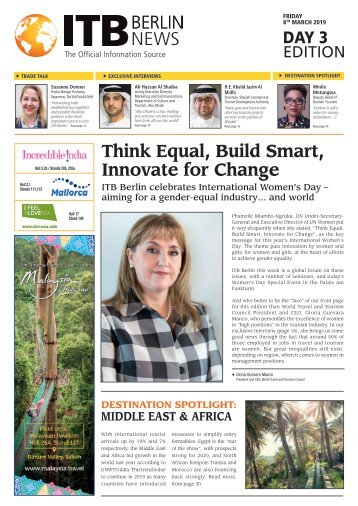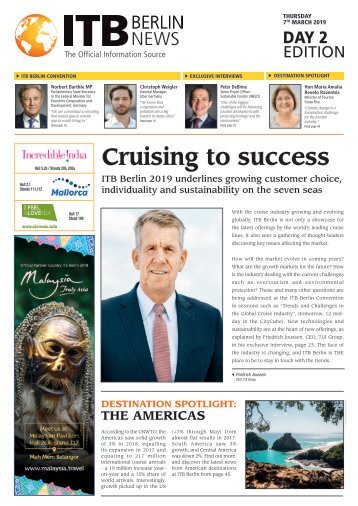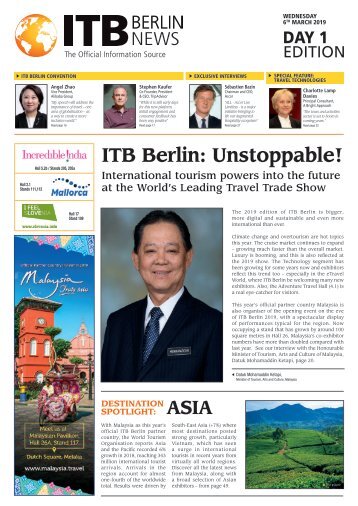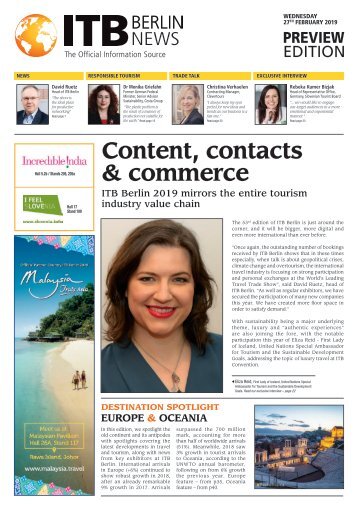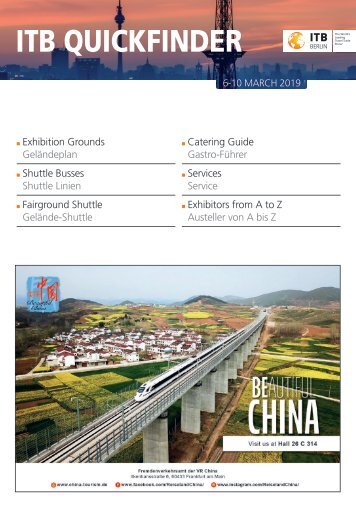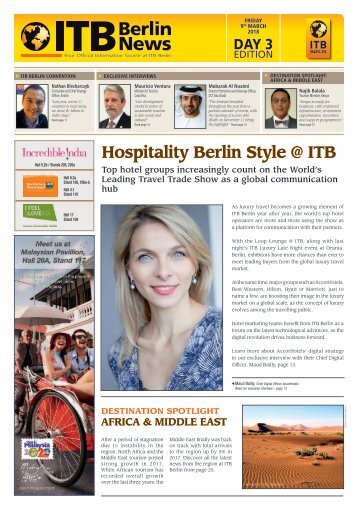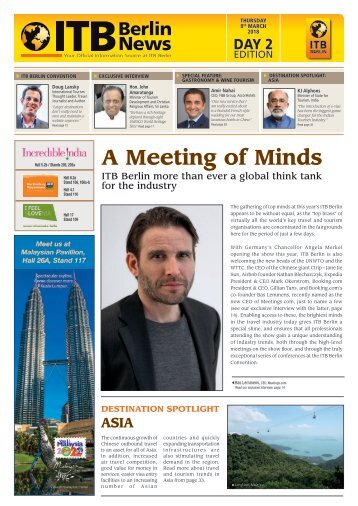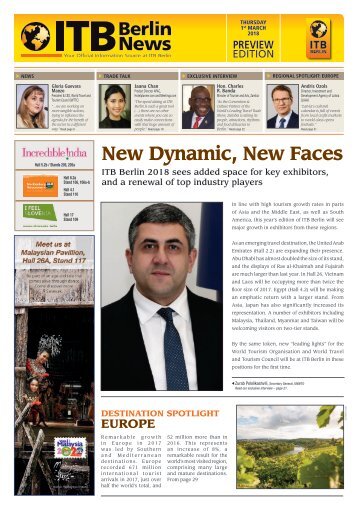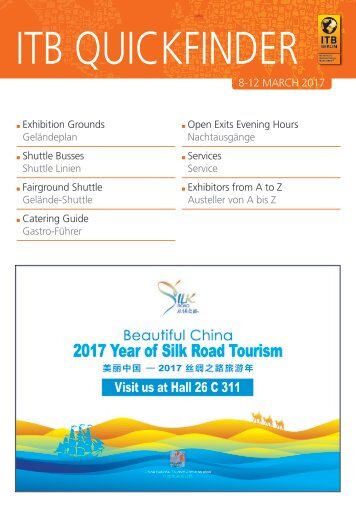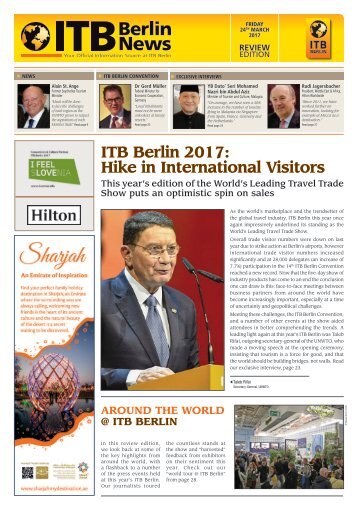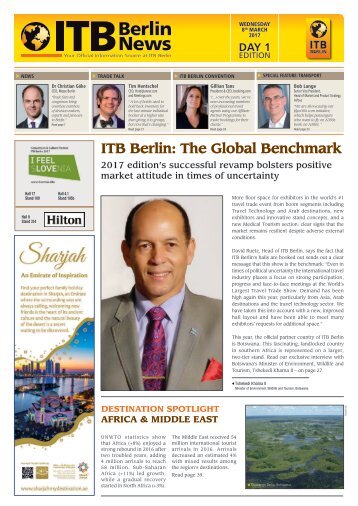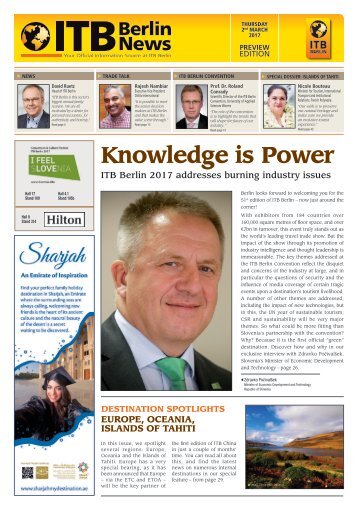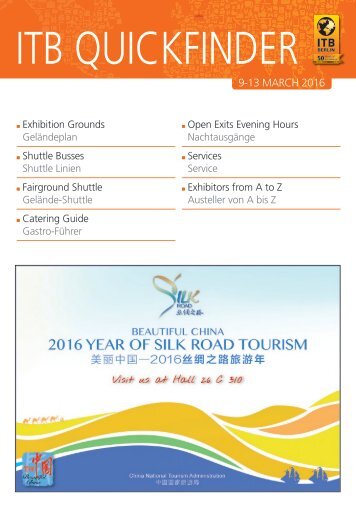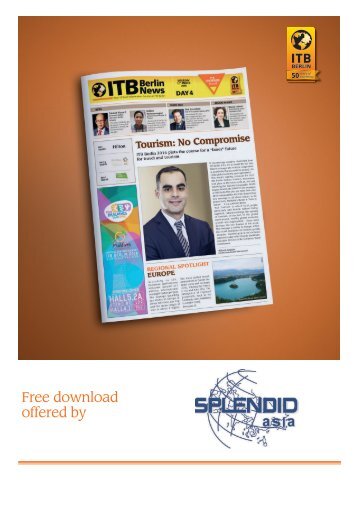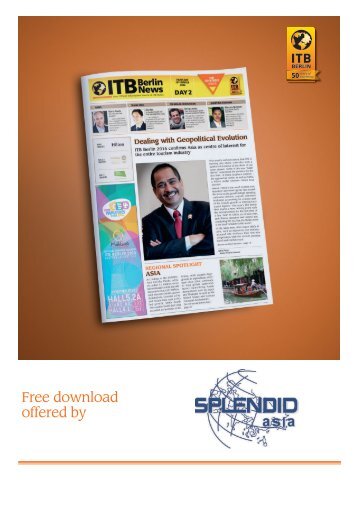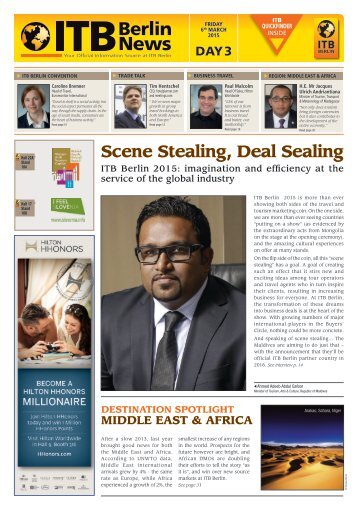
ITB Berlin News - Day 4
- Text
- Hotels
- Tourism
- Tours
- Resort
- Berlin
- Resorts
- Tourismus
- Halle
- Exhibitors
- Aussteller
26 REGION EUROPE My
26 REGION EUROPE My Serbia Must-See Lithuania In the year that Lithuania adopted the Euro, the Baltic State’s presence at ITB Berlin 2015 marks a growth in tourism. Jurgita Kazlauskiene, Director General of the Lithuanian State Department of Tourism, pointed out that “The growth of foreign tourist flows in Lithuania is well above the European average. About 2.2million international visitors came to our country in 2014, marking an increase of 8%. At the same time, Lithuanians themselves showed more interest (+10%) in travelling around their home country.” Listed third behind Singapore and Namibia in Lonely Planet’s Best In Travel Top Ten Countries, Lithuania has Jurgita Kazlauskiene Director General, Lithuanian State Department of Tourism a variety of new ways to market itself. Promoting city trips, in particular to the capital Vilnius with its improved accessibility, new business and boutique hotels and new attractions is one priority, as is the country’s status as one of the world’s leading amber destinations thanks to its new initiative the World Amber Road. “With the inauguration of the Euro in January of this year, travelling in Lithuania is even easier and will make the destination even more popular among Europeans,” said Kazlauskiene. Hall 18 Stand 126b Gordana Plamenac CEO of the National Tourism Organisation of Serbia reveals exciting plans for Belgrade and the surrounding countryside. Situated at the crossroads of Europe, at the centre of the Balkan peninsula, the Republic Of Serbia exhibits at ITB Berlin with a new agenda to encourage tourism to the country. ITB Berlin News asked Gordana Plamenac, CEO of the National Tourism Organisation of Serbia, what key messages she has been delivering this week. Serbia has a new promotional campaign for 2015. The message behind “My Serbia” is “bring along your friend” and features outdoor holidays in the national parks and protected natural reserves of Serbia, including winter and summer adventure holidays. The campaign also brings to light the abundance of tourism events throughout Serbia in all seasons, such as music festivals, gastronomic events, the eight wine regions of Serbia, cultural events and celebrations that add spice to the rich and diverse Serbian tourism product. We also want to encourage our many summer holiday activities for children and families, plus there is also special emphasis on promoting the Danube River for tourism and cruising. -Belgrade has just been named by Rough Guides as one of Europe’s ten “must visit” cities. What makes it so attractive? Belgrade has rapidly earned a reputation that positions Serbia’s capital not only as the heart of the Balkans but also as a place which offers a multitude of experiences and attractions for the visitor. As well as Rough Guides, Lonely Planet and Conde Nast have also rated Belgrade as one of the top 10 must see destinations in the world. A blend of traditional and modern, friendly and welcoming people, together with a combination of an active nightlife and a laid-back cultural and social rhythm of life contribute to its reputation. In the light of recent renewed interest in the work of electrical engineering pioneer Nikola Tesla, how important to Belgrade is the presence of The Nikola Tesla Museum? Nikola Tesla Museum is the only museum in the world which preserves the original and personal inheritance of the legendary scientist and visionary Nikola Tesla. A particular role of the Museum is the promotion of the history of science. It will also lead to global recognition of Tesla’s contribution to the development of science and engineering at the end of the 19th, and beginning of the 20th, century. Gordana Plamenac CEO of the National Tourism Organisation of Serbia How do you leverage ITB Berlin to help increase tourism business in Serbia? How important is this show for you? Being here at ITB is immeasurably valuable for us. German tourists rank highly (number 5) on the list of international tourism arrivals and overnights in Serbia, so the local market LONELY PLANET AND CONDE NAST HAVE ALSO RATED BELGRADE AS ONE OF THE TOP 10 MUST SEE DESTINATIONS IN THE WORLD is crucial. But in conjunction with our partners we also seek to promote ourselves internationally, and to leverage the event to attract new partners for the future. Hall 2.2 Stand 211 ITB BERLIN NEWS • Saturday 7 th March 2015 www.itb-berlin-news.com
EUROPE REGION 27 Germany: Tourism For All Petra Hedorfer, CEO, German National Tourist Board has ambitious plans for Destination Germany The Danube Flows Through ITB Berlin 2015 Cross-Border Tourism - Best Practices @ ITB Berlin 2015 highlights the great European river The longest river in the European Union, the Danube flows 1,914km from Germany to Ukraine and passes through four capital cities (Vienna, Bratislava, Budapest and Belgrade) on the way. As such, it is both an essential destination for European tourism and travel and the symbolic backbone of pan- European co-operation in the sector. To make the most of this, in 2010 the Danube Competence Centre (DCC) was founded to unite public, private and non-government organisations involved in tourism along the river. Now with a network of more than 70 members, the DCC is once again present at ITB Berlin this year presenting fresh ideas to potential clients as well as partaking in several conferences, workshops and events. Wednesday saw a Danube Forum entitled “Cross-Border Tourism - Best Practices” which was headlined by Gordana Plamenac (CEO, National Tourism Organization Serbia and also DCC’s Chair of the Board Of Directors) and brought together delegates from across ITB Berlin’s relevant exhibitors with one goal in mind: to ensure co-operation of thinking and marketing between the many nations, organisations, TOs and products leveraging the Danube for business, despite the political and logistical borders to be crossed. Naturally, the promotion of the Danube as a tourist product involves traditional experiences like national parks, city breaks and cultural heritage. But travelling both on and beside the liquid landmark are key development areas. The growing importance of river cruises in the market requires new approaches to the sector from all parties, maximising the potential of a river that is perfectly placed for the activity – as discussed at Friday morning’s River Cruise Workshop at ITB Berlin. Alongside the waterway, improved paths, connectivity, facilities and infrastructure for cycling along the Danube Bike Trail are also highlighted. With more than half a million cyclists visiting the most popular section, between Passau, Germany and Vienna, Austria, in 2014, the potential for increased business with operators working in tandem is clear. CEO of the German National Tourist Board (GNTB) and following her three-year tenure as President of the European Travel Commission, Petra Hedorfer talks to ITB Berlin News about strong growth in tourism in this country in 2014. Incoming tourism to Germany is continually growing. In 2014, the number of overnight stays by visitors from abroad rose by 5 per cent to more than 75million according to preliminary figures by the Federal Statistical Office. This has given us a new record for the fifth year IT IS BOTH POSSIBLE AND REALISTIC THAT BY 2030 WE WILL SEE A FURTHER RISE OF ALMOST 80% IN INCOMING TOURISM INTO GERMANY in a row. These growth figures show that Germany is competing extremely well in the international arena. According to UNTWO, in 2014 the number of international arrivals increased by 4.7% worldwide and 3.9% in Europe compared to the previous year. Thus we have been able to secure a proportionate share of the worldwide growth in tourism and increase our market share within Europe, the world’s top tourist destination. What are your key messages at ITB Berlin 2015? It is both possible and realistic that by 2030 we will see a further rise of almost 80% in incoming tourism into Germany, with over 121-million overnight stays by foreign visitors. This is the prediction of a long-term forecast that we have developed over recent months. We have analysed various sources; for example forecasts by the UNWTO, the WTTC, estimates of potential for source markets and statistical data from recent years. The current forecast forms a valid basis for the future development and the strategic direction of global marketing for Destination Germany. What are your priorities and plans in marketing Germany? Through our two-year ‘Germany Reunified’ campaign, we are showcasing the tourism highlights that have enriched Destination Germany for 25 years since the fall of the Berlin Wall in 1989 and German Reunification in 1990. Our ‘Traditions and Customs’ theme campaign links the modern, positive image of Destination Germany with its authentic, living traditions which are firmly entrenched in Petra Hedorfer CEO, German National Tourist Board contemporary society. Apart from that the concept of sustainability plays an important role in our marketing for Destination Germany, as well as promoting the revival of rural areas through tourism. A further central theme in GNTB’s marketing is accessible travel or “Tourism for All”. At the “Barrier Free Tourism Day” at ITB Berlin 2015 we discussed along with many international experts, ‘opportunities and potential’ of this growing market segment. In 2016 the GNTB will be focusing its worldwide marketing activities on the theme “Holidays in the heart of nature“, placing particular emphasis on the tourism potential of rural regions. Germany boasts 15 national parks, 15 UNESCO biosphere reserves and 104 nature parks offering a wide choice of holidays in the great outdoors. Hall 12 Stand 102 ITB BERLIN NEWS • Saturday 7 th March 2015
- Page 1: SATURDAY 7 th MARCH 2015 DAY 4 ITB
- Page 5 and 6: NEWS 5 CONTENTS News...............
- Page 7 and 8: NEWS 7 Outgoing German Tourist Mark
- Page 9 and 10: ITB BERLIN CONVENTION 9 Respecting
- Page 11 and 12: EXCLUSIVE INTERVIEW 11 from selecte
- Page 13 and 14: WORLD EXPO SPECIAL FEATURE 13 The N
- Page 15 and 16: WELLNESS & MEDICAL TOURISM SPECIAL
- Page 18 and 19: 18 SPECIAL FEATURE ADVERTORIAL GAST
- Page 20 and 21: 20 SPECIAL FEATURE LGBT TRAVEL ITB
- Page 22 and 23: 22 SPECIAL FEATURE ADVERTORIAL LGBT
- Page 24 and 25: 24 REGION EUROPE Europe’s Online
- Page 28 and 29: 28 REGION EUROPE Georgia - Variety
- Page 30: 30 WHERE TO GOIN BERLIN Restaurants
- Page 34 and 35: EXHIBITION GROUNDS GELÄNDEPLAN Hal
- Page 36 and 37: SHUTTLE BUSSES & FAIRGROUND SHUTTLE
- Page 38 and 39: SERVICES SERVICE Airports Informati
- Page 40 and 41: EXHIBITORS FROM A TO Z AUSTELLER VO
- Page 42 and 43: EXHIBITORS FROM A TO Z AUSTELLER VO
- Page 44: EXHIBITORS FROM A TO Z AUSTELLER VO
- Page 47 and 48: D / E / F EXHIBITORS / AUSSTELLER H
- Page 49 and 50: F / G / H EXHIBITORS / AUSSTELLER H
- Page 51 and 52: H / I / J / K EXHIBITORS / AUSSTELL
- Page 53 and 54: K / L / M EXHIBITORS / AUSSTELLER H
- Page 55 and 56: M / N / O EXHIBITORS / AUSSTELLER H
- Page 57 and 58: O / P / Q / R EXHIBITORS / AUSSTELL
- Page 59 and 60: R / S EXHIBITORS / AUSSTELLER HALL
- Page 61 and 62: S / T EXHIBITORS / AUSSTELLER HALL
- Page 63 and 64: T / U / V EXHIBITORS / AUSSTELLER H
Inappropriate
Loading...
Mail this publication
Loading...
Embed
Loading...
